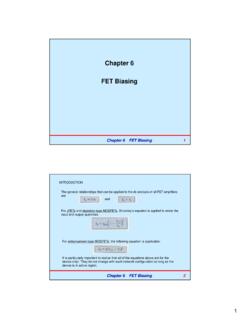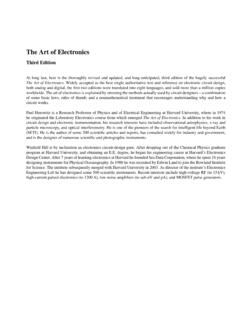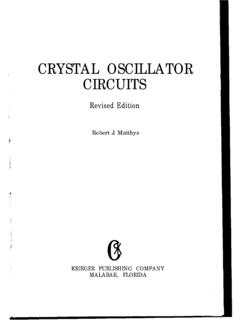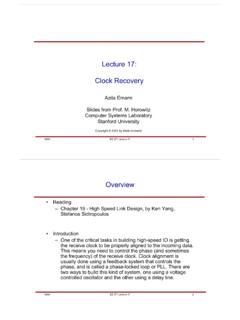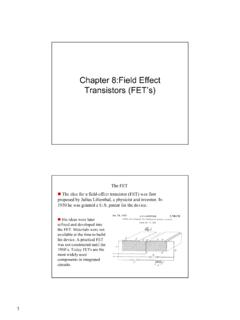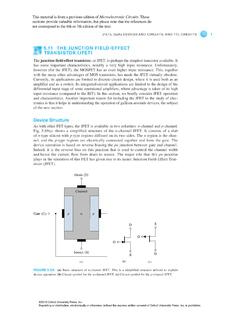Transcription of Audio Power Amplifier - de Smith
1 Audio PowerAmplifierDesign HandbookAudio PowerAmplifierDesign HandbookFourth editionDouglas Self MA, MScAMSTERDAM BOSTON HEIDELBERG LONDON NEW YORK OXFORDPARIS SAN DIEGO SAN FRANCISCO SINGAPORE SYDNEY TOKYON ewnes is an imprint of ElsevierNewnes is an imprint of ElsevierLinacre House, Jordan Hill, Oxford OX2 8DP30 Corporate Drive, Burlington, MA 01803 First published 2006 Copyright 2006, Douglas Self. All rights reservedThe right of Douglas Self to be identified as the author of this work has beenasserted in accordance with the Copyright, Designs and Patents Act 1988No part of this publication may be reproduced in any material form (includingphotocopying or storing in any medium by electronic means and whether or nottransiently or incidentally to some other use of this publication) without the writtenpermission of the copyright holder except in accordance with the provisions of theCopyright, Designs and Patents Act 1988 or under the terms of a licence issuedby the Copyright Licensing Agency Ltd, 90 Tottenham Court Road, London,England W1T 4LP.
2 Applications for the copyright holder s written permission toreproduce any part of this publication should be addressed to the publisherPermissions may be sought directly from Elsevier s Science and Technology RightsDepartment in Oxford, UK: phone: (+44) (0) 1865 843830; fax: (+44) (0) 1865853333; e-mail: You may also complete your requeston-line via the Elsevier homepage ( ), by selecting Customer Support and then Obtaining Permissions British Library Cataloguing in Publication DataSelf, DouglasAudio Power amplifier design handbook. 4th Audio amplifiers Design 2. Power amplifiers DesignI. 81535 Library of Congress Control Number:2006927666 ISBN-13: 978-0-7506-8072-1 ISBN-10: 0-7506-8072-5 For information on all Newnes publicationsvisit our web site at and bound inGreat Britain0607080910 10987654321 Working together to grow libraries in developing | | to Fourth EditionxviiPrefacexviii1. Introduction and general survey12. History, architecture and negative feedback313.
3 The general principles of Power amplifiers624. The small signal stages755. The output stage I1096. The output stage II1667. Compensation, slew-rate, and stability1868. Power supplies and PSRR2399. Class-A Power amplifiers25910. Class-G Power amplifiers29411. Class-D amplifiers31912. FET output stages32813. Thermal compensation and thermal dynamics33914. The design of DC servos38515. Amplifier and loudspeaker protection39716. Grounding and practical matters43217. Testing and safety454 Index464vSynopsisChapter 1 Introduction and general surveyThe economic importance of Power amplifiersAssumptionsOrigins and aimsThe study of amplifier designMisinformation in audioScience and subjectivismThe Subjectivist positionA short history of subjectivismThe limits of hearingArticles of faith: the tenets of subjectivismThe length of the Audio chainThe implicationsThe reasons whyThe outlookTechnical errorsThe performance requirements for amplifiersSafetyReliabilityPower outputFrequency responseNoiseDistortionDamping factorAbsolute phaseAcronymsChapter 2 History.
4 Architecture and negativefeedbackA brief history of amplifiersAmplifier architecturesviiSynopsisThe three-stage architectureThe two-stage amplifier architecturePower amplifier classesClass-AClass-ABClass-BClass-CClas s-DClass-EClass-FClass-GClass-HClass-SVa riations on Class-BError-correcting amplifiersNon-switching amplifiersCurrent-drive amplifiersThe Blomley principleGeometric mean Class-ABNested differentiating feedback loopsAC- and DC-coupled amplifiersThe advantages of AC-couplingThe advantages of DC-couplingNegative feedback in Power amplifiersSome common misconceptions about negative feedbackAmplifier stability and NFBM aximising the NFBM aximising linearity before feedbackChapter 3 The general principles of poweramplifiersHow a generic amplifier worksThe advantages of conventionThe eight distortionsDistortion one: input stage distortionDistortion two: VAS distortionDistortion three: output stage distortionDistortion four: VAS loading distortionDistortion five: rail decoupling distortionDistortion six: induction distortionDistortion seven: NFB takeoff distortionDistortion eight: capacitor distortionNon-existent distortionsThe performance of a standard amplifierOpen-loop linearity and how to determine itviiiSynopsisDirect open-loop gain measurementUsing model amplifiersThe concept of the blameless amplifierChapter 4 The small signal stagesThe role of the input stageDistortion from the input stageBJTs vs FETs for the input stageAdvantages of the FET input stageDisadvantages of FET input stageSingleton input stage versus differential pairThe input stage distortion in isolationInput stage balanceThe joy of current-mirrorsImproving input-stage linearityRadical methods of improving input linearityInput stage cascode configurationsInput noise and how to reduce itOffset and match.
5 The DC precision issueThe input stage and the slew-rateThe voltage-amplifier stageMeasuring VAS distortion in isolationVAS operationVAS distortionLinearising the VAS: active load techniquesVAS enhancementsThe importance of voltage driveThe balanced VASThe VAS and manipulating open-loop bandwidthManipulating open-loop bandwidthConclusionsChapter 5 The output stage IClasses and devicesThe distortions of the outputHarmonic generation by crossover distortionComparing output stagesThe emitter-follower outputThe CFP outputQuasi-complementary outputsTriple-based output configurationsTriple EF output stagesDistortion and its mechanismsixSynopsisLarge-signal distortion (Distortion 3a)The load-invariant conceptThe LSN mechanismDoubled output devicesBetter output devicesFeedforward diodesTrouble with triplesLoads below 4 Better 8 performanceA practical load-invariant designThe latest findingsSummaryCrossover distortion (Distortion 3b)Output stage quiescent conditionsAn experiment on crossover distortionVqas the critical quiescent parameterSwitching distortion (Distortion 3c)
6 Thermal distortionThermal distortion in a Power amp ICSelecting an output stageClosing the loop: distortion in complete amplifiersConclusionsChapter 6 The output stage IIDistortion number 4: VAS loading distortionDistortion number 5: rail decoupling distortionDistortion number 6: induction distortionDistortion number 7: NFB takeoff point distortionDistortion number 8: capacitor distortionDesign example: a 50 W Class-B amplifierChapter 7 Compensation, slew-rate,and stabilityFrequency compensation in generalDominant-pole compensationLag compensationIncluding the output stage: inclusive Miller compensationNested feedback loopsTwo-pole compensationOutput networksAmplifier output impedanceMinimising amplifier output impedanceZobel networksxSynopsisOutput inductorsThe output inductor valueCable effectsCrosstalk in amplifier output inductorsConclusionsReactive loads and speaker simulationResistive loadsModelling real loudspeaker loadingLoudspeaker loads and output stagesSingle-speaker loadTwo-way speaker loadsEnhanced loudspeaker currentsAmplifier instabilityHF instabilityLF instabilitySpeed and slew-rate in Audio amplifiersThe basics of amplifier slew-limitingSlew-rate measurement techniquesImproving the slew-rateSimulating slew-limitingSlewing limitations in real lifeSome additional complicationsFurther improvements and other configurationsChapter 8 Power supplies and PSRRP ower supply technologiesSimple unregulated Power suppliesLinear regulated Power suppliesSwitch-mode Power suppliesDesign considerations for Power suppliesMains
7 TransformersFusing and rectificationRF emissions from bridge rectifiersPower supply-rail rejection in amplifiersA design philosophy for rail rejectionPositive supply-rail rejectionNegative supply-rail rejectionChapter 9 Class-A Power amplifiersAn introduction to class-AClass-A configurations and efficiencyOutput stages in Class-AQuiescent current control systemsA novel quiescent current controllerxiSynopsisA Class-A designThe trimodal amplifierLoad impedance and operating modeEfficiencyOn Trimodal biasingClass-A/AB modeClass-B modeThe mode-switching systemThermal designA complete Trimodal amplifier circuitThe Power supplyThe performanceFurther possibilitiesChapter 10 Class-G Power amplifiersThe principles of Class-GIntroducing series class-GEfficiency of Class-GPracticalitiesThe biasing requirementsThe linearity issues of series Class-GThe static linearityPractical Class-G designControlling small-signal distortionThe performanceDeriving a new kind of amplifier: Class-A+CAdding two-pole compensationFurther variations on Class-GChapter 11 Class-D amplifiersHistoryBasic principlesTechnologyProtectionOutput filtersEfficiencyChapter 12 FET output stagesThe characteristics of Power FETSFET versus BJT output stagesAdvantages of FETsDisadvantages of FETsxiiSynopsisIGBTsPower FET output stagesPower FETs and bipolars: the linearity comparisonFETs in Class-A stagesChapter 13 Thermal compensationand thermal dynamicsWhy quiescent conditions are criticalAccuracy required of thermal compensationBasic thermal compensationAssessing the bias errorsThermal simulationModelling the EF output stageModelling the CFP output stageThe integrated absolute error criterionImproved thermal compensation.
8 The emitter-follower stageImproved compensation for the CFP output stageA better sensor positionA junction-temperature estimatorA junction estimator with dynamicsConclusionVariable-tempco bias generatorsCreating a higher tempcoAmbient temperature changesCreating a lower tempcoCurrent compensationThermal dynamics in realityResultsEarly effect in output stagesChapter 14 The design of DC servosDC offset trimmingDC offset control by servo-loopThe advantages of DC servosBasic servo configurationsNoise, component values, and the roll-offNon-inverting integratorsChoice of op-ampsServo authorityDesign of LF roll-off pointPerformance issuesMultipole servosxiiiSynopsisChapter 15 Amplifier and loudspeakerprotectionCategories of amplifier protectionSemiconductor failure modesOverload protectionOverload protection by fusesElectronic overload protectionPlotting the protection locusSimple current-limitingSingle-slope VI limitingDual-slope VI limitingSimulating overload protection systemsCatching diodesDC-offset protectionDC protection by fusesRelay protection and muting controlFiltering for DC ProtectionBidirectional DC DetectionDistortion in output relaysOutput crowbar DC protectionProtection by Power -supply shutdownThermal protectionPowering auxiliary circuitryChapter 16 Grounding and practical mattersAudio amplifier PCB designCrosstalkRail induction distortionThe mounting of output devicesSingle and double-sided PCBsPower supply PCB layoutPower amplifier PCB layout detailsThe Audio PCB
9 Layout sequenceMiscellaneous pointsAmplifier groundingGround loops: how they work and how to deal with themHum injection by mains grounding currentsHum injection by transformer stray magnetic fieldsHum injection by transformer stray capacitanceGround currents inside equipmentBalanced mains powerClass I and Class IIWarningxivSynopsisMechanical layout and design considerationsCoolingConvection coolingMains transformersWiring layoutSemiconductor installationChapter 17 Testing and safetyTesting and fault-findingSafetySafety regulationsElectrical SafetyEquipment temperature and safetyInstruction manualsxvI wish to dedicate this book to my parents Russell and Evelyn, and to allthe friends and colleagues who have provided me help, information andencouragement while I was engaged in its writing. In particular I wantto acknowledge the active assistance and collaboration of Gareth Connorin the quest for the perfect amplifier, and the fortitude of Peter King inenduring many rambling expositions of my thoughts on the to FourthEditionThe Audio Power Amplifier Design Handbook has now reached its Fourthedition, and it is very good to see that it fulfils a real need.
10 It has once againbeen expanded with a significant amount of new material. This time twowhole new chapters have been added, one on the Design of DC Servos forcontrolling output offsets and another on Class-D Amplifiers, which havegrown markedly in importance in recent have also been major new sections added on the detailed designof DC protection circuitry, and on the Safety regulations. No DC-coupledpower amplifier can be regarded as complete until it has proper DCprotection having an amplifier fail is bad enough, but having it fail andtake an expensive loudspeaker with it is downright upsetting. If you aredesigning an amplifier for commercial production, then a knowledge ofthe various safety requirements is of course vital; such considerations canhave a profound effect on how a piece of equipment is would like to thank everyone who has supported me in the productionand evolution of The Handbook, not least those who have done so bybuying design of Power amplifiers exerts a deep fascination all of its own inboth amateur and professional circles.
